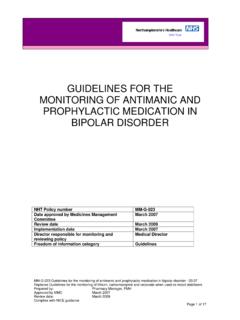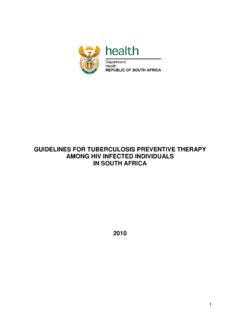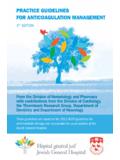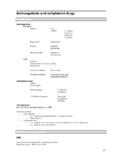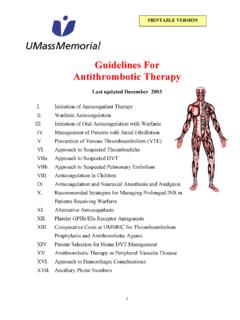Transcription of Guidelines for the management of Vitamin D …
1 Corby Clinical Commissioning Group Kettering General Hospital NHS Trust Nene Clinical Commissioning Group Northampton General Hospital NHS Trust Northamptonshire Healthcare Foundation Trust Guidelines for the treatment and prophylaxis of Vitamin D deficiency in children and adolescents Background Vitamin D compounds are fat soluble sterols which are essential for the absorption and utilisation of calcium and phosphorus (in the form of inorganic phosphate) in the body to maintain normal calcification of the skeleton and bone 1,2. mineralisation Along with parathyroid hormone (PTH) the active form of Vitamin D (25 OHD) regulates serum calcium concentration by altering serum calcium and inorganic phosphate blood levels as needed.
2 It maintains 2. neuromuscular function and various other cellular processes, including the immune system and insulin production Recommended daily intake All UK Health Departments recommend: All pregnant and breastfeeding women should take a daily supplement containing 10 micrograms of Vitamin D, to ensure that the mother's requirements for Vitamin D are met and to build adequate foetal stores for early infancy. All infants and young children aged 6 months to 5 years should take a daily supplement containing Vitamin D. in the form of Vitamin drops, to help them meet these requirements; Infants under 6 months 340 IU ( micrograms) daily and 6 months 5 years 280 IU (7 micrograms) daily.
3 NB: Infants being fed infant formula will not need Vitamin drops until they are receiving less than 500ml of infant formula a day, as these products are fortified with Vitamin D. Breastfed infants may need to receive drops containing Vitamin D from one month of age if their mother has not taken Vitamin D supplements throughout pregnancy. Adults/adolescents who are not exposed to much sun should also take a daily supplement containing 400 IU. 3,4. (10 micrograms). The major natural source of Vitamin D is from skin photosynthesis following ultraviolet B sunlight exposure. Over 90%.
4 Of the body's Vitamin D is produced from the action of sunlight on the skin. Small amounts of Vitamin D are also 3,4. obtained from oily fish, egg yolks, mushrooms, fortified breakfast cereals, milk and margarine. Risks factors for Vitamin D deficiency Vitamin D deficiency develops when there is inadequate exposure to sunlight or a lack of Vitamin D in the diet and usually takes a long time to develop because of the slow release of the Vitamin from body stores. Prolonged Vitamin D deficiency in infants and children results in rickets. Less severe Vitamin D deficiency (usually referred to as Vitamin D insufficiency) is often associated with secondary hyperparathyroidism and increased bone 3.
5 Loss, leading to high risk of fractures. The Chief Medical Officer (CMO) has issued advice on Vitamin D supplementation for people at risk of Vitamin D. deficiency. Risk factors for reduced Vitamin D levels include: Dark/pigments skin colour black, Asian populations Routine use of sun protection factor 15 and above as this blocks 99% of Vitamin D synthesis. Reduced skin exposure cultural reasons (clothing). Latitude (In the UK, there is no radiation of appropriate wavelength between October and March). Chronic ill health with prolonged hospital admissions oncology patients Children and adolescents with disabilities which limit the time they spend outside Institutionalised individuals Photosensitive skin conditions Reduced Vitamin D intake Maternal Vitamin D deficiency Infants that are exclusively breast fed Dietary habits low intake of foods containing Vitamin D.
6 Abnormal Vitamin D metabolism, abnormal gut function, malabsorption or short bowel syndrome. Chronic liver or renal disease Medicines including rifampicin, isoniazid and anti-convulsants phenytoin and carbamazepine, glucocorticoids and highly active anti-retroviral treatment . 3,4. Genetic variation. Indications for measurement of Vitamin D. Symptoms and signs of rickets/osteomalacia Progressive bowing deformity of legs Waddling gait Abnormal knock knee deformity (intermalleolar distance > 5 cm). Swelling of wrists and costochondral junctions (rachitic rosary). Prolonged bone pain (>3 months duration).
7 Symptoms and signs of muscle weakness Delayed walking Difficulty climbing stairs Cardiomyopathy in an infant Abnormal bone profile or x-rays Low plasma calcium or phosphate Raised alkaline phosphatase Osteopenia or changes of rickets on x-ray Pathological fractures Disorders impacting on Vitamin D metabolism Chronic renal failure Chronic liver disease Malabsorption syndromes, for example, cystic fibrosis, Crohn's disease, coeliac disease Older anticonvulsants, for example, phenobarbitone, phenytoin, carbamazepine Children with bone disease in whom correcting Vitamin D deficiency prior to specific treatment would be indicated Osteogenesis imperfecta Idiopathic juvenile osteoporosis 5.
8 Osteoporosis secondary to glucocorticoids, inflammatory disorders, immobility Measurement of Vitamin D. Confirmation of Vitamin D deficiency is by measurement of serum levels of 25 OHD, which is the main circulating form of Vitamin D (also known as calcidiol). 3,6. There is no agreed definition for Vitamin D deficiency . A plasma concentration of <25 nanomol/L for 25-OHD levels 3,6,7, has been used as the lower limit of adequacy of Vitamin D status deficiency. There is no consensus on optimal 1,6. levels of serum 25 OHD, some experts suggest that a desirable 25 OHD concentration is > 75 nanomol/l.
9 Insufficiency falls between deficient and desirable levels. There are no defined limits, so insufficiency can be quoted 8. as any of the following: 25 50 nanomol/l, 25 75 nanomol/l or > 35 nanomol/l . Vitamin D levels, effects on health and management of deficiency 3. Serum 25 (OH) D concentration level Vitamin D status Manifestation management < 25 nmol/l (10micrograms/l) Deficient Rickets, osteomalacia Treat with high dose Vitamin D. 25 50 nmol/l (10 20micrograms/l Insufficient Associated with disease Vitamin D. risk supplementation OTC Not to be prescribed 50 75 nmol/l (20 30micrograms/l) Adequate Healthy Lifestyle advice > 75 nmol/l (30 micrograms/l) Optimal Healthy None Flowchart for children with suspected Vitamin D deficiency Does the child have any risk factors or symptoms?)
10 No investigations required No . Lifestyle advice Yes Risk Factors Only . Children under the age of 5 years: Lifestyle advice and Vitamin D supplementation . Purchase OTC or via Healthy Start o Under 1 year: 200 units Vitamin D once daily o 1 - 4 years: 400 units Vitamin D once daily Risk Factors AND Symptoms/. Signs Children 5 years and over offer lifestyle advice . Lifestyle advice Investigations Therapeutic intervention Arrange Investigations Renal function, Calcium, Phosphate, Magnesium (infants), Alkaline phosphatase, Does the patient meet all the criteria for 25-OH Vitamin D levels, Urea and management in Primary Care?



